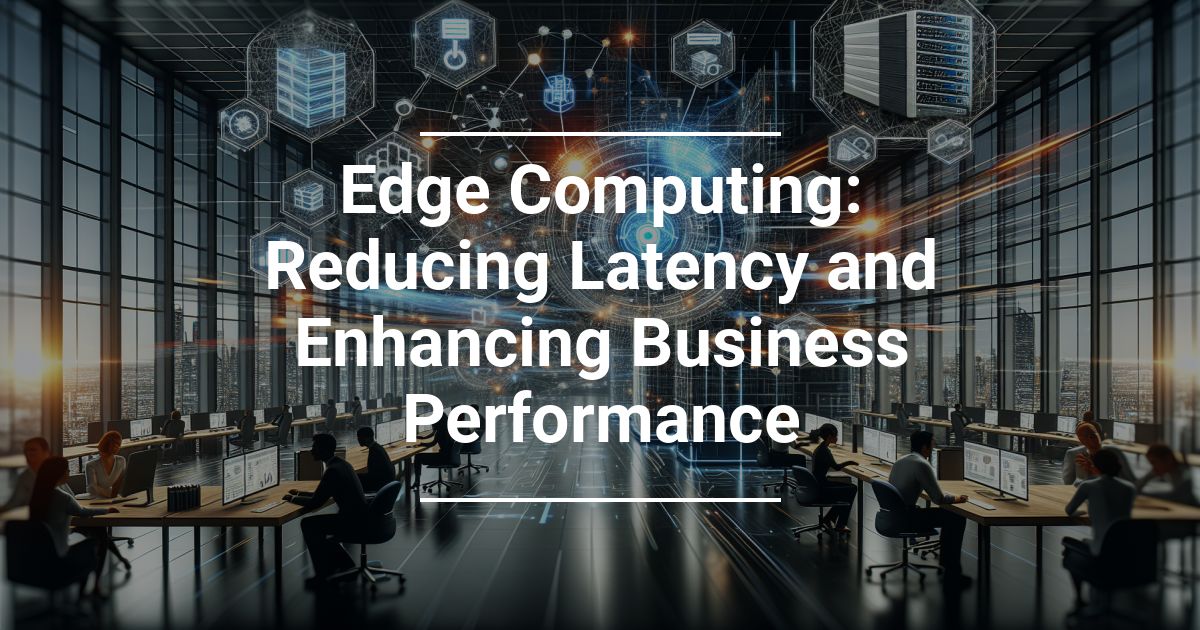
What Is Edge Computing and How Can It Transform Your Business?
In today’s digital landscape, businesses manage multiple online processes, from handling customer queries across platforms to transferring data between systems. As companies grow and incorporate more devices, such as IoT tools, phones, and smart devices, latency becomes an issue that could prevent your business from operating at peak performance.
The more complex your infrastructure, the greater the strain on your network. This can lead to slower response times, poor user experiences, and even data security vulnerabilities. The good news is that edge computing can help businesses overcome these challenges, offering faster processing, stronger security, and real-time decision-making.
In this article, we’ll explore the advantages of edge computing, compare it to traditional cloud infrastructure, and discuss how it can enhance your company’s operations. By the end, you’ll have a clearer understanding of whether edge computing is the right solution for your business.
What Is Edge Computing?
Edge computing is a distributed computing model that brings data processing closer to the devices generating the data. Instead of sending all information to a centralized cloud server or data center, edge computing uses local servers—called edge nodes—to handle data processing. This reduces the distance data needs to travel, decreases latency, and enables faster, real-time decision-making.
With edge computing technology, businesses can optimize their networks, improve efficiency, and enhance data security, making it a perfect fit for industries that rely heavily on real-time data processing like manufacturing, healthcare, and retail.
Centralized Cloud Computing vs. Edge Computing
In a traditional cloud computing setup, all devices and systems connect to a centralized cloud or data center. This means data from every device is sent to one location for processing before it can be sent back to the originating device. As a result, businesses can experience network congestion, increased latency, and higher data transfer costs, particularly when handling large amounts of data.
Here’s a breakdown of how cloud computing compares to edge computing:
- Latency: Cloud computing can experience delays due to data traveling over long distances, while edge computing processes data closer to the source, reducing lag.
- Security: Cloud computing involves sending data across networks, which can be vulnerable to breaches. Edge computing processes data locally, reducing security risks and providing enhanced data protection.
- Bandwidth: Cloud-based systems can put a strain on bandwidth as large amounts of data are transmitted to and from the cloud. Edge computing reduces the amount of data traveling across networks, optimizing bandwidth usage.
- Cost: Cloud solutions often require more bandwidth and storage, which can lead to higher costs. With edge computing, businesses can lower these costs by processing data on-site.
Why Edge Computing Matters for Businesses
The transition to edge computing offers several key benefits that can transform business operations, especially for companies seeking to scale or manage high volumes of data. Here’s how edge computing solutions can positively impact your business:
1. Reduce Latency and Improve User Experience
With edge computing, data no longer needs to travel long distances to be processed, which significantly reduces latency. This can be crucial for businesses where real-time data processing is essential, such as smart manufacturing, retail, and logistics.
For example, in retail, edge computing allows point-of-sale systems and IoT devices to process transactions faster, improving the customer experience. In manufacturing, edge computing helps analyze machine performance in real-time, preventing equipment failures and minimizing downtime.
2. Enhanced Data Security
A key advantage of edge computing is its ability to enhance data security. In traditional cloud setups, raw, unencrypted data must travel across public networks, increasing the risk of interception and data breaches.
By processing data locally within edge servers, businesses can maintain tighter control over their sensitive information. Additionally, when data must be sent to the cloud, it’s encrypted first, providing extra layers of security. This is especially valuable for industries like finance, healthcare, and government, where data privacy is paramount.
3. Scalability and Cost Efficiency
As businesses expand, the need to manage more data grows. Edge computing offers a scalable solution, allowing businesses to add more edge nodes as necessary without overwhelming the central cloud system. This can significantly reduce bandwidth consumption, optimize resource allocation, and lower operational costs.
In industries like healthcare or education, where large amounts of data are generated daily, edge computing ensures that organizations can handle these increases efficiently while keeping costs under control.
4. Real-Time Data Processing and AI Integration
Edge computing unlocks the power of real-time decision-making by allowing businesses to process data locally and immediately. This is particularly useful when combined with artificial intelligence (AI) and machine learning capabilities, which can analyze vast datasets and make predictions or automate processes in real-time.
For example, AI-powered edge computing can monitor customer sentiment across social media platforms, alerting businesses to potential issues or providing insights into customer behavior. In logistics, real-time data from sensors can optimize fleet management, reducing fuel consumption and delivery times.
How Edge Computing Can Drive Business Growth
Businesses that implement edge computing are better positioned to capitalize on their data. Whether it’s improving operational efficiency, securing sensitive information, or making faster decisions, edge computing gives companies the tools they need to stay ahead of the competition.
As more industries adopt edge computing to streamline their processes, reduce costs, and enhance data security, the question isn’t whether you should invest in edge computing but when. Future-proofing your business today with edge computing means greater flexibility, faster innovation, and better overall performance tomorrow.
Is Edge Computing Right for Your Business?
While edge computing offers incredible benefits, it’s not a one-size-fits-all solution. Understanding your business’s needs, the volume of data you handle, and how you want to optimize operations will determine whether edge computing is the right fit.
At Micro Solutions, we specialize in helping businesses assess their unique requirements and implement the right edge computing solutions. Our expert team is here to guide you through every step of the process, ensuring a smooth transition that integrates seamlessly into your existing infrastructure.
Final Thoughts on Edge Computing
As businesses continue to embrace digital transformation, edge computing is emerging as a crucial tool for enhancing performance, increasing security, and enabling real-time processing. If your business is ready to take the next step and unlock the full potential of your data, consider adopting edge computing solutions that align with your goals.
At Micro Solutions, we’re committed to helping you find the right technology to drive your business forward. Contact us today to learn more about how edge computing can enhance your company’s operations.
FAQs About Edge Computing
What industries benefit the most from edge computing?
Edge computing is particularly useful in industries like healthcare, manufacturing, retail, logistics, and finance where real-time data processing, security, and scalability are essential.
How does edge computing improve security?
By processing data locally on edge nodes, edge computing keeps sensitive information within your network, reducing the risk of data breaches during data transmission.
Can edge computing replace cloud computing?
No, edge computing complements cloud computing by offloading certain tasks to local servers, while the cloud handles large-scale data storage and processing needs.



